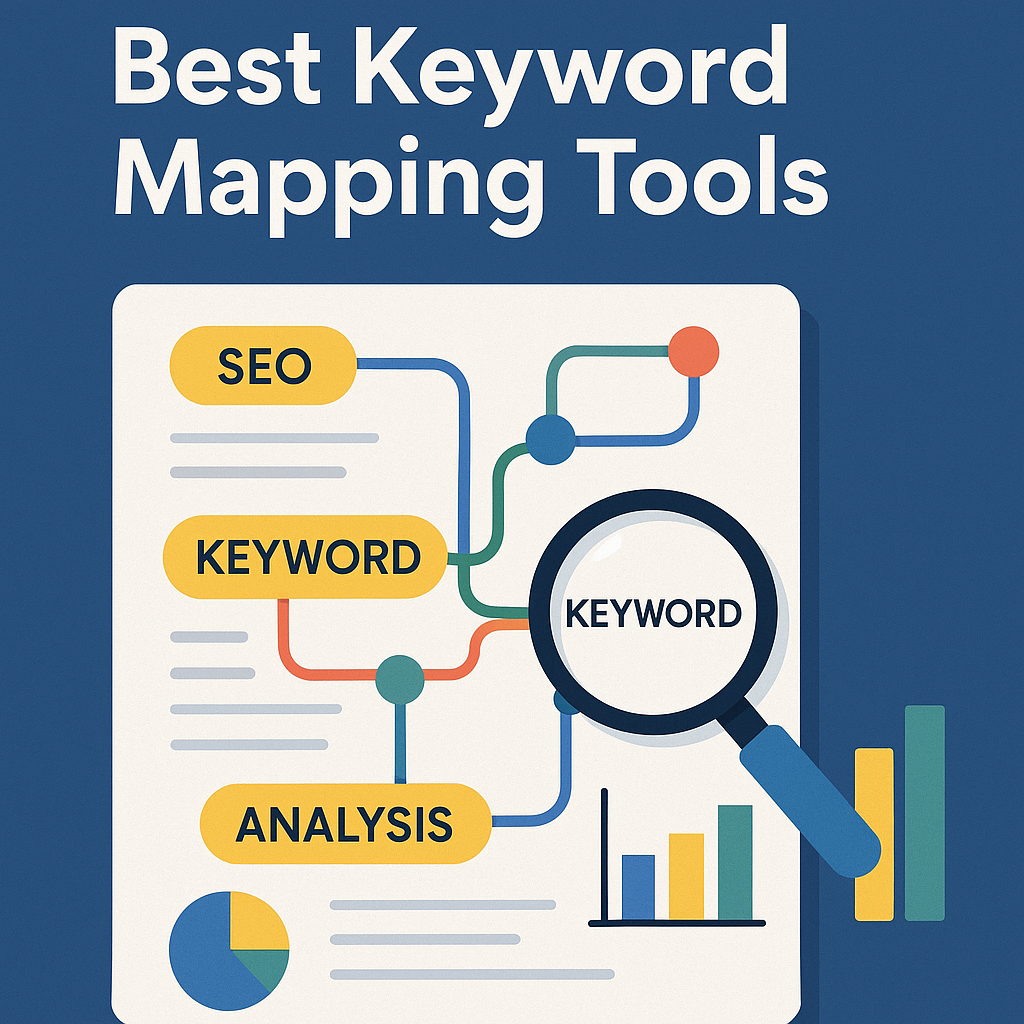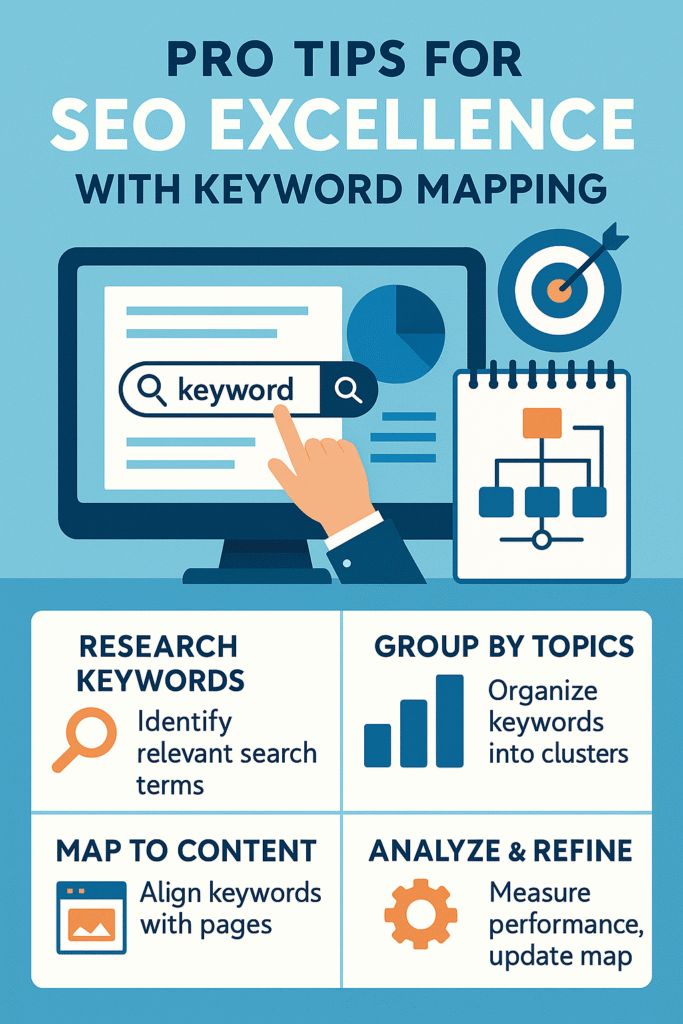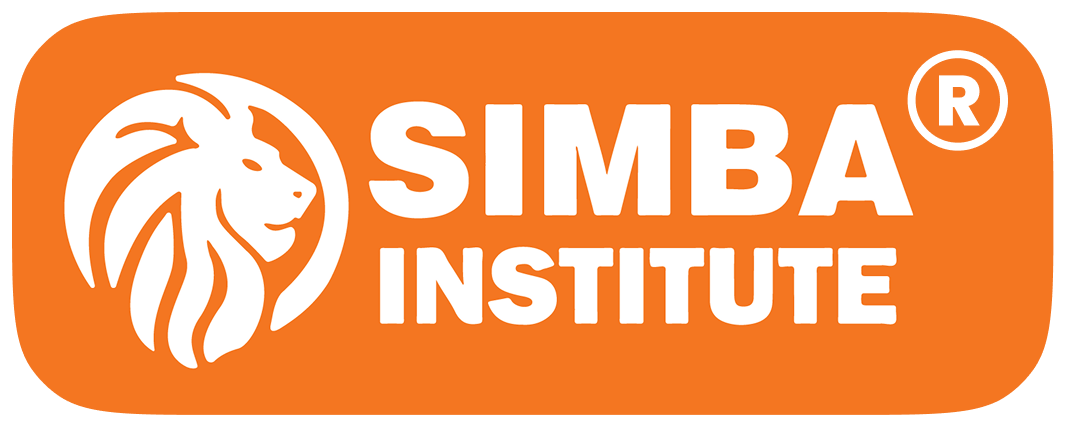Search
People also search for:
Keyword Mapping Tools and Tips for SEO ExcellenceI
Keyword Mapping Tools and Tips for SEO ExcellenceI
- Home
- Keyword Mapping Tools and Tips for SEO ExcellenceI
Keyword Mapping Tools and Tips for SEO ExcellenceI

In the evolving world of digital marketing, search engine optimization (SEO) remains a cornerstone of any successful online strategy. But behind every well-optimized website lies a meticulous process that often goes unnoticed — keyword mapping.
Keyword mapping is the strategic process of assigning relevant keywords to specific pages on a website. It’s where SEO meets site architecture and content strategy, ensuring that every page has a clear purpose, aligns with search intent, and minimizes internal competition (also known as keyword cannibalization). Done well, keyword mapping can dramatically improve search visibility, organic traffic, and user experience.
In this module of our Digital Marketing Course, we’ll dive deep into the importance of keyword mapping, explore the best tools to streamline the process, and share expert tips to help you achieve SEO excellence.
What is Keyword Mapping?
At its core, keyword mapping is the practice of matching relevant keywords or keyword clusters to specific URLs on your website. The goal is to ensure that each page targets unique, strategically chosen search terms that reflect both user intent and SEO opportunity.
For example:
Your homepage might target broad keywords like “Digital Marketing Services”
Your blog post might target a long-tail keyword like “Best Keyword Mapping Tools for SEO”
Your course page could target “Advanced Digital Marketing Course Online”
A clear, well-structured keyword map helps avoid keyword cannibalization (when multiple pages compete for the same keyword), improves user experience, and signals to search engines what each page is about – all of which are crucial for higher rankings.
Why is Keyword Mapping Important for SEO Excellence?
Here’s why keyword mapping deserves a central place in your SEO strategy:
Enhanced Relevance
Mapping ensures that every page on your site answers a specific search intent. Search engines reward relevance — so clear keyword-page alignment boosts your chances of ranking.
Prevents Keyword Cannibalization
Without keyword mapping, multiple pages might unknowingly target the same keyword, splitting ranking power and confusing Google. Mapping eliminates this overlap.
Improves Content Strategy
A well-laid keyword map exposes content gaps and opportunities for new pages or blog posts. It ensures your website covers your niche comprehensively.
Streamlines Internal Linking
By understanding keyword clusters and page relationships, you can build a smarter internal linking structure that improves crawlability and user navigation.
Facilitates SEO Reporting & Optimization
When each page has clear keyword targets, tracking rankings and adjusting strategies becomes far simpler and more data-driven.
Best Keyword Mapping Tools

Ahrefs:
Known for its robust keyword research and site audit features, Ahrefs makes it easy to identify keyword difficulty, search volume, and content gaps. Use its Keyword Explorer and Site Explorer together to map keywords effectively.
SEMrush:
With features like Keyword Magic Tool and Position Tracking, SEMrush allows you to group keywords, analyze competitors, and map them to existing or new pages seamlessly.
Google Search Console:
Free and direct from Google, GSC shows which keywords your pages currently rank for. It’s invaluable for refining your existing keyword map based on real search performance.
Screaming Frog SEO Spider:
This website crawler lets you audit your site structure, identify duplicate content, and export all URLs — an excellent foundation before layering in keyword data.
Keyword Cupid
An AI-powered keyword clustering tool, Keyword Cupid groups thousands of keywords into logical clusters based on search engine results page (SERP) similarity. It’s ideal for advanced keyword mapping.
Google Sheets or Excel
While not a research tool per se, spreadsheets are crucial for visualizing and organizing your keyword map. Templates and color coding help bring clarity to complex projects.
Step-by-Step Keyword Mapping Process:
Step 1: Conduct Thorough Keyword Research
Use tools, SEMrush, or Google Keyword Planner to gather a comprehensive list of relevant keywords in your niche. Be sure to capture:
Primary keywords (high volume, high relevance)
Secondary keywords (related variants)
Long-tail keywords (specific, lower competition)
Semantic keywords (LSI — Latent Semantic Indexing terms)
Step 2: Group Keywords into Clusters
Instead of mapping single keywords to pages, modern SEO favors topic clusters. Group related keywords that share search intent. For example:
Cluster Example:
- Digital Marketing Course
- Best Online Marketing Course
- SEO & PPC Training Online
This ensures your page is comprehensive and aligned with how Google understands topics today.
Step 3: Audit Existing Website Content
Use Screaming Frog or similar tools to crawl your site and inventory all URLs. Determine which existing pages are best suited for the keyword clusters, and identify gaps where new content is needed.
Step 4: Map Keywords to URLs
Using a spreadsheet, assign your clusters to the most relevant URLs. Your sheet should include:
- Target URL
- Primary keyword
- Secondary/related keywords
- Content type (Blog, Product Page, Service Page, etc.)
- Notes on optimization status (e.g., Needs Update, To Create)
Step 5: Optimize On-Page SEo
Ensure each page is optimized for its target keywords:
- Use keywords naturally in title tags, headers, and meta descriptions
- Incorporate keywords in URL slugs and alt text
- Write comprehensive, high-quality content that covers the cluster’s topic in-depth
Step 6: Track Performance & Refine
Using Google Search Console and SEMrush, monitor how your pages rank for their target keywords over time. Adjust your map as you publish new content or see shifts in keyword trends.
Pro Tips for SEO Excellence with Keyword Mapping:

1.Prioritize Search Intent Over Search Volume
A keyword with lower search volume but high conversion intent can often be more valuable than a broad, high-volume keyword. Focus on what your audience wants, not just what they search.
2. Use Competitor Analysis for Inspiration
Tools like SEMrush let you analyze competitors’ top-performing pages and their keyword targets. Identify gaps you can fill or strategies to outperform.
3. Incorporate Semantic SEO
Google’s algorithms understand topics holistically. Don’t just focus on exact-match keywords – include related terms, synonyms, and concepts to build topical authority.
4. Balance Commercial and Informational Keywords
Your keyword map should mix transactional keywords (to drive sales) and informational ones (to attract awareness and build authority). This creates a full-funnel content strategy.
5. Update Your Keyword Map Regularly
SEO isn’t static. Revisit your map quarterly to account for new keyword opportunities, shifts in user behavior, and Google algorithm updates.
Keyword Mapping in a Digital Marketing Course Context
If you’re building or promoting a digital marketing course, keyword mapping takes on even more importance. You’re competing in a saturated niche with varied user intents – from beginners seeking free resources to professionals looking for certification courses.
Consider these keyword clusters:
Beginner Intent: “What is digital marketing?”, “Digital marketing basics”
Course Intent: “Best digital marketing course online”, “SEO certification course”
Career Intent: “Digital marketing career guide”, “Jobs after digital marketing course”
By mapping these clusters strategically to specific pages (landing pages, blog posts, FAQs, testimonials), you can guide prospects seamlessly through the funnel – from awareness to enrollment.
Digital marketing course :
Simba institute:

- This institute is the best option for your digital marketing career.
- In which your career becomes better.
- Simba Institute also provides online courses.
- Apart from digital marketing, many other courses are also available at Simba Institute.
- My own experience at Simba Institute was ,
- This institute is the best.
- I got training there to take my career further.
- Every question is answered properly.
- The technique of explaining here is also good.
- The practice team is also the best team.
- Internship is also provided.
- They explain in the best way with practical.
Benefits:
This institute offers courses in both online and offline modes, provides guidance in the local language, and also awards certificates.
Conclusion:
Keyword mapping isn’t just a technical SEO task – it’s a strategic blueprint for how your entire website communicates with both search engines and users.
When done right, it ensures that:
- Every page has a clear purpose
- Your content resonates with user intent
- Your site architecture supports both SEO and UX
- You gain measurable, sustainable organic growth


